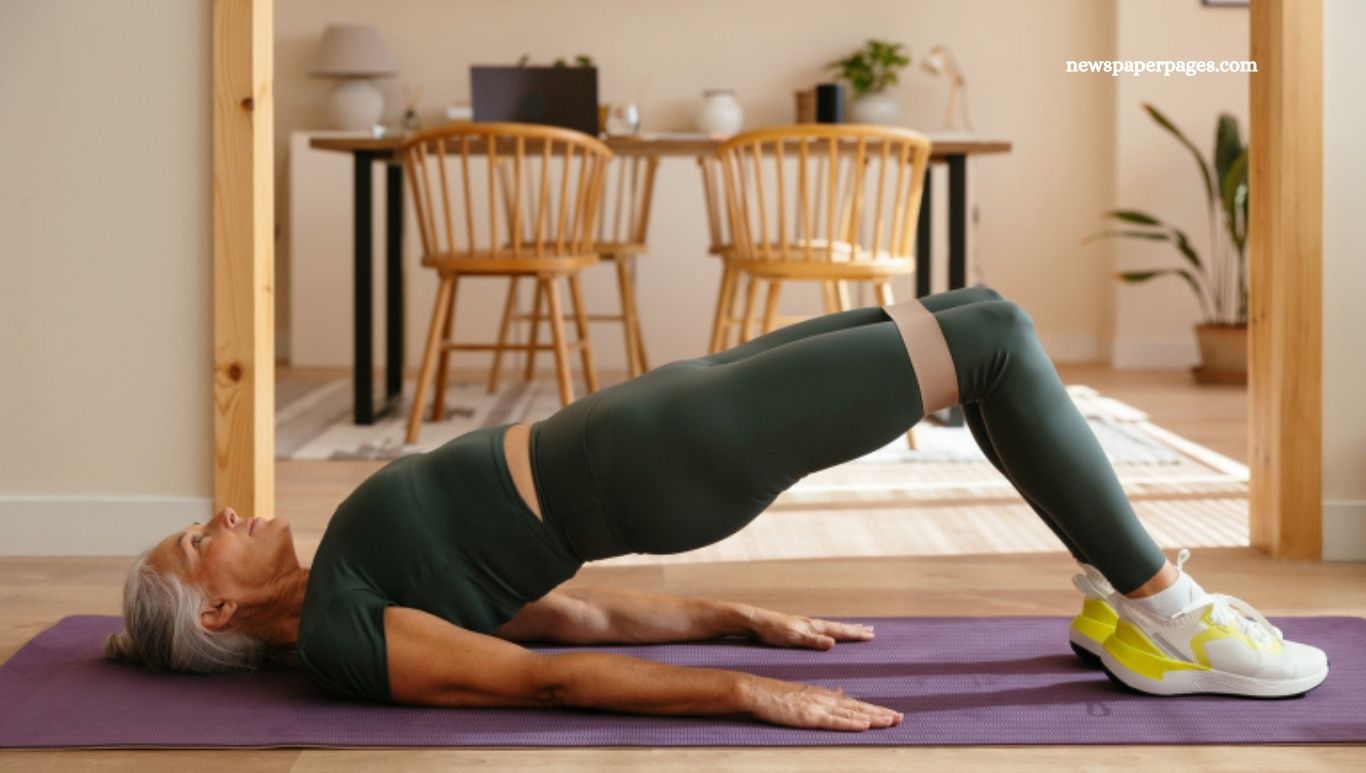Sitting for long periods weakens your glutes, leaving them soft and underused, says physical therapist and performance coach Haley Harrison, DPT, CSCS. This muscle loss—often called “mom butt” during pregnancy—is common but fixable. Adding targeted glute exercises to your weekly routine can build strength and shape. Combine classic strength moves with fresh, glute-focused exercises to revive and sculpt your backside.
The benefits of doing flat butt exercises
Glute Gains Go Beyond Looks
Building a sculpted butt is a great bonus, but glute workouts offer real functional perks. Strong glutes improve everyday movements like standing, climbing stairs, and even chasing after your dog. “The glutes play a key role in functional movement,” says physical therapist Haley Harrison, DPT, CSCS. These muscles—gluteus maximus, medius, and minimus—work together to stabilize and support your hips and lower body.
Read More: Do Nasal Strips Improve Workouts? Expert Insights Revealed
Injury Prevention Starts with Strong Glutes
Engaging your glutes activates the entire posterior chain, including hamstrings and the lower back. “These muscles are essential for injury prevention,” Harrison explains. Weak glutes can throw off alignment and contribute to back and knee pain. “The stronger our glutes, the more stable and healthy our back becomes,” adds fitness coach Ashley Selman, CSCS.
Boost Running Performance with Glute Power
For runners, strong glutes mean better speed and endurance. The glute medius and minimus stabilize the pelvis during each stride, while the glute max powers your push-off. Research even shows a direct link between larger glutes and faster sprint times.
The 3 keys to effective flat butt workouts
Target Your Glutes, Not Your Quads or Hamstrings
Many people perform glute exercises but fail to activate the glutes properly, often feeling it in their quads or hamstrings instead. “Activating the glutes is harder than you think,” says Olivia Lord, CPT. Sitting tightens hip flexors and quads, inhibiting glute engagement, explains Ashley Selman, CSCS. Loosen hips first with stretches like the kneeling hip flexor stretch. When squatting or lunging, lean your torso slightly forward to shift the work onto your glutes, says Haley Harrison, DPT.
Train All Three Glute Muscles for Balanced Growth
For a full, rounded backside, target the gluteus maximus, medius, and minimus. Banded walks and fire hydrants shape the side glutes and create that “shelf” look, while squats and deadlifts build the glute max for a bubble butt effect, notes Selman. Compound heavy lifts form the foundation of sculpted glutes, adds Harrison, improving strength and stability for better overall gains.
Lift Heavy and Progressively Overload
Heavier weights build larger, fast-twitch muscle fibers that add size and shape. Selman advises favoring heavier loads over high-rep light weights to maximize growth. To keep improving, increase the challenge steadily—using heavier weights, tighter bands, or higher platforms. “Muscles only grow when you gradually increase the load,” Harrison emphasizes.
The 9 best flat butt exercises
Add these flat butt exercises to your routine 2–3 times a week for noticeable results.
Loaded Squats

Squats are a staple in flat butt workouts because they effectively activate the glutes. The secret is to get low and reach deep hip flexion while leaning slightly forward to engage your glutes, explains Ashley Selman, CSCS.
How to Perform Loaded Squats:
- Stand with feet shoulder-width apart, toes slightly turned out. Hold a kettlebell or dumbbells close to your chest.
- Maintain a neutral spine and lean your torso slightly forward. Bend your knees and hips to lower your glutes down and back, as if sitting into a chair. Lower until your hips are at or just below knee level.
- Drive through your heels to return to standing.
- Perform 10–12 reps for 3–4 sets.
Deadlifts

Deadlifts effectively target the glutes by hinging at the hips and bringing your trunk closer to your legs, says both Selman and Harrison.
How to Perform Deadlifts:
- Stand with feet hip-width apart. Place a barbell or kettlebell just in front of your shins.
- Hinge at the hips with a neutral spine, bending your knees slightly. Grab the weight with an overhand grip.
- Drive through your hips to lift your torso until you’re standing upright.
- Slowly lower the weight back to the floor by hinging at the hips.
- Complete 10–12 reps for 3–4 sets.
Hip thrust

The hip thrust is a top glute-building exercise recommended by all three experts. Ashley Selman emphasizes focusing on the end range of motion—tucking the pelvis, squeezing the glutes, and maximizing hip extension. For beginners, a glute bridge is a great alternative.
How to Perform Hip Thrusts:
- Sit with your back against a bench, positioned at the bottom of your shoulder blades. Place a loaded barbell across your hips.
- Drive through your heels to lift your hips until fully extended.
- Pause at the top, squeezing your glutes for 2 seconds, then slowly lower back down.
- Complete 10–12 reps for 3–4 sets.
Bulgarian split squats



This exercise targets the glutes by placing most of the effort on the front leg. “The glutes work to keep the knee from collapsing inward,” explains Haley Harrison, DPT. With balancing support from the back foot, it’s a great introduction to single-leg training.
How to Perform Bulgarian Split Squats:
- Place your back foot on a bench or platform behind you. Position your front foot a couple of feet ahead on the ground. Hold weights in both hands or just on the side of your back foot.
- Lean your torso slightly forward and lower your body until the back knee nearly touches the floor.
- Push through your front heel to return to standing.
- Perform 8–12 reps, then switch sides. Complete 3–4 sets.
Step-ups


Increasing the platform height amps up glute activation, says Haley Harrison. As you get stronger, raise the step to challenge your muscles further.
How to Perform Step-Ups:
- Stand facing a sturdy platform like a box or bench. Place one foot on it, holding weights either in both hands or on the same side as your back foot.
- Push through the front foot to fully stand on the platform.
- With your torso slightly leaned forward, lower down to lightly tap your back foot on the floor.
- Repeat for 8–12 reps, then switch sides. Complete 3–4 sets.
Single-leg deadlifts



This variation targets your glutes twice over: the medius and minimus engage to maintain balance, while the maximus drives the hip hinge.
How to Perform Single-Leg Deadlifts:
- Stand on your right foot, holding a weight in your left hand.
- Hinge at the hips, leaning your torso forward and extending your left leg straight back.
- Return to standing.
- Perform 8–12 reps, then switch sides. Complete 3–4 sets.
Wall drill


This move improves hip mobility and targets the upper glute max—especially helpful if tight hip flexors limit your glute activation, explains Ashley Selman, CSCS.
How to Perform Wall-Supported Glute Kickbacks:
- Stand facing a wall with your hands at chest height, leaning in slightly.
- Lift one knee toward the wall while pushing through the opposite leg as if sprinting. This opens the hip flexor and maximally engages the glute.
- Hold the position for 5 seconds, then switch legs. Increase difficulty by pressing harder into the wall and floor.
- Complete 6 reps per leg for 2–3 sets.
Banded side-to-side walks
This exercise targets the gluteus medius and minimus, helping lift and stabilize your backside. To keep progressing, use stronger resistance bands or widen your stance for more tension, advises Haley Harrison, DPT.
How to Perform Banded Side Steps:
- Stand with feet hip-width apart and place a mini band around your thighs just above the knees.
- Lower into a shallow squat.
- Step sideways, stretching the band while keeping your feet pointed forward.
- Return feet to hip-width apart, maintaining band tension.
- Repeat 8–12 steps in each direction for 3–4 sets.
Fire hydrant
A classic move targeting the glute medius, fire hydrants become more effective with a mini band around your lower thighs for added resistance.
How to Perform Fire Hydrants:
- Begin in a tabletop position on your hands and knees.
- Lift one knee out to the side as high as possible, keeping hips stable.
- Lower the knee back down without resting your weight on it.
- Perform 8–12 reps, then switch sides. Complete 3–4 sets.
Frequently Asked Questions
How often should I do these glute exercises?
For optimal results, perform these exercises 2 to 3 times per week, allowing rest days for muscle recovery and growth.
How long does it take to see results from glute workouts?
Most people notice improvements in strength and shape within 4 to 8 weeks with consistent training and proper nutrition.
Can I do these exercises at home without equipment?
Yes! Many of these moves, like fire hydrants and banded side steps, can be done with minimal or no equipment. Adding weights or resistance bands will boost effectiveness.
What’s the difference between the gluteus maximus, medius, and minimus?
The gluteus maximus is the largest muscle, responsible for hip extension and power. The medius and minimus stabilize the pelvis and help with hip abduction and rotation, crucial for balance and shaping.
Can these exercises help reduce lower back pain?
Strengthening your glutes supports better posture and pelvic alignment, which can alleviate and prevent some types of lower back pain.
Should I focus on heavy weights or higher reps for glute growth?
Heavier weights with moderate reps (8–12) promote muscle size and strength by targeting fast-twitch muscle fibers. Progressive overload is key for continued gains.
Are these exercises safe for beginners?
Yes! Start with bodyweight or light resistance and focus on proper form. Exercises like glute bridges and wall-supported kickbacks are great beginner options.
How do I ensure I’m properly activating my glutes during these workouts?
Warm up with hip flexor stretches to loosen tight muscles, lean your torso slightly forward during squats and lunges, and focus on mind-muscle connection to “feel” your glutes working.
Conclusion
Building a strong, shapely backside goes beyond aesthetics—it improves your overall strength, stability, and injury prevention. Incorporating these 9 targeted glute exercises into your routine, performed consistently 2 to 3 times per week, can help you transform a flat butt into a firm, well-rounded one. Focus on proper form, progressive overload, and activating all three glute muscles for the best results. Whether you’re a beginner or looking to take your workouts to the next level, these exercises provide a balanced approach to building shape and strength that lasts.

